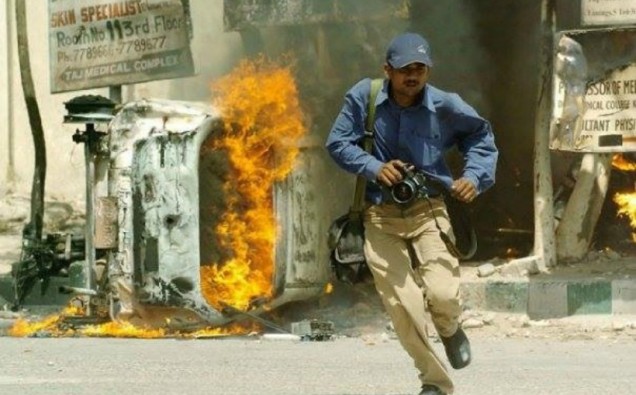
Photo above shows a photographer in the line of duty, returning after getting a close shot of a burning vehicle. Photo Credit : Aziz Ahmed for Views and News
The death of 71 journalists in 2015 capped another deadly year for media people worldwide with nearly 40 percent falling victims to brutalities of terror groups such as al-Qaeda and Islamic State, according to a global watchdog.
More than two-thirds of the total killed were directly targeted for their work, says the Committee to Protect Journalists which has been tracking plight of journalists since 1992. In as much as 84 percent of the cases, there were no convictions.
In spite of growing danger to their lives, journalists remain the main source of information from the areas of conflict.
With 14 deaths, Syria topped the list of most dangerous countries for journalists in the year under review. Engulfed in a multi-faceted war since the eruption of Arab Spring in 2011, Syria has seen more journalists killed in 2012, 2013 and 2014 that combined outnumber those in the rest of the world.
The total number of deaths in Syria in 2015 was less than the previous three years, which, according to CPJ, was in part due to the fact that major international news organizations chose not to send staff to the country and local journalists fled.
But the Committee is also finding it increasingly difficult to research cases in Syria and other parts of the world, ravaged by conflict. The CPJ says it undertook a research mission in 2015 to investigate reports that up to 45 journalists from Mosul were missing, dead, or held captive by ISIL, but could confirm the deaths of only a handful, due to the group’s strong hold on the city.
At least four freelance journalists were reported missing in Syria in 2015, three of them were said to have disappeared in the city of Aleppo.
Eight journalists were killed in a single attack on the office of satirical magazine Charlie Hebdo in Paris in January, making France the second deadliest country for journalist in the past year. Al-Qaeda claimed the responsibility.
Bangladesh in South Asia was another country where murders of a publisher and four bloggers were suspected to be the handiwork of a local extremist group, Ansarullah Bangla Team, according to CPJ. These included a U.S.-Bangladeshi writer Avijit Roy.
In Pakistan, al-Qaeda-linked Taliban militants claimed responsibility for killing at least one journalist in 2015, but several others were either killed and wounded in attacks in which motives could not be clearly established. Pakistan was the deadliest country for media persons in 2014 with 14 deaths.
Other countries with high number of deaths include Brazil (6), Yemen, Iraq, South Sudan (5 each) and Mexico (4). Three journalists were killed each in Somalia and Turkey and two in the United States. One death each was reported in Kenya, Libya, Ukraine, India, Guatemala, Congo, Ghana and Poland.
According to CPJ, criminal groups, government officials, drug traffickers and local authorities suspected of having links with organized crime accounted for one-third of the total killings worldwide in 2015. The most common beat covered by the slain journalists was politics, followed by war and human rights, the CPJ says.
A total of 1177 journalists have been killed in the line of duty since CPJ began tracking death of media people in 1992.














